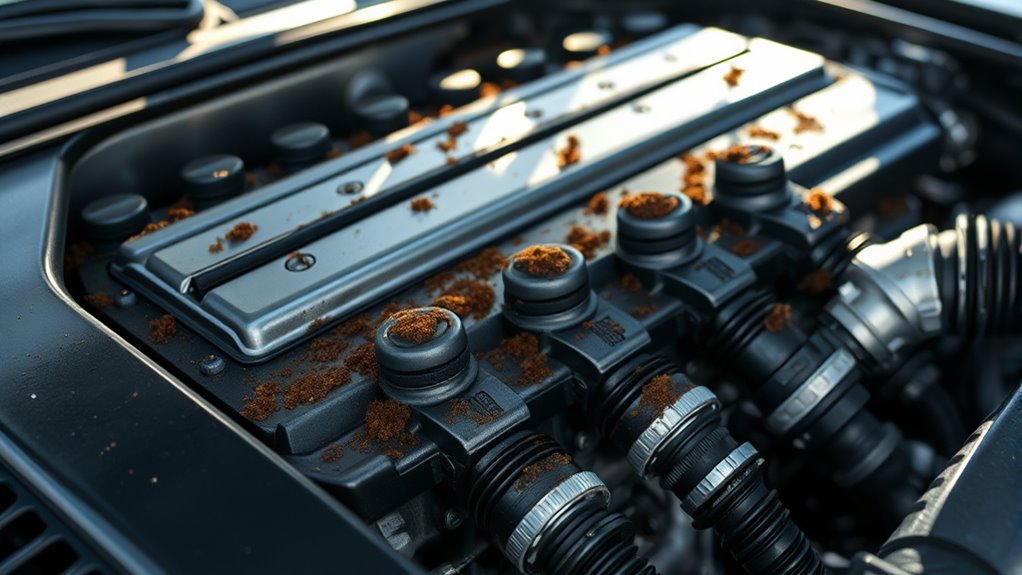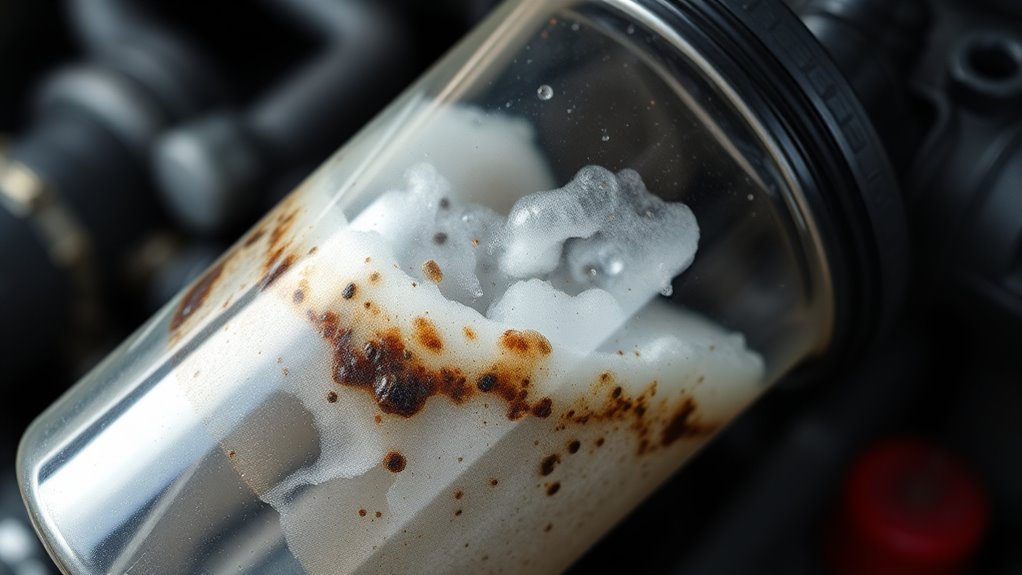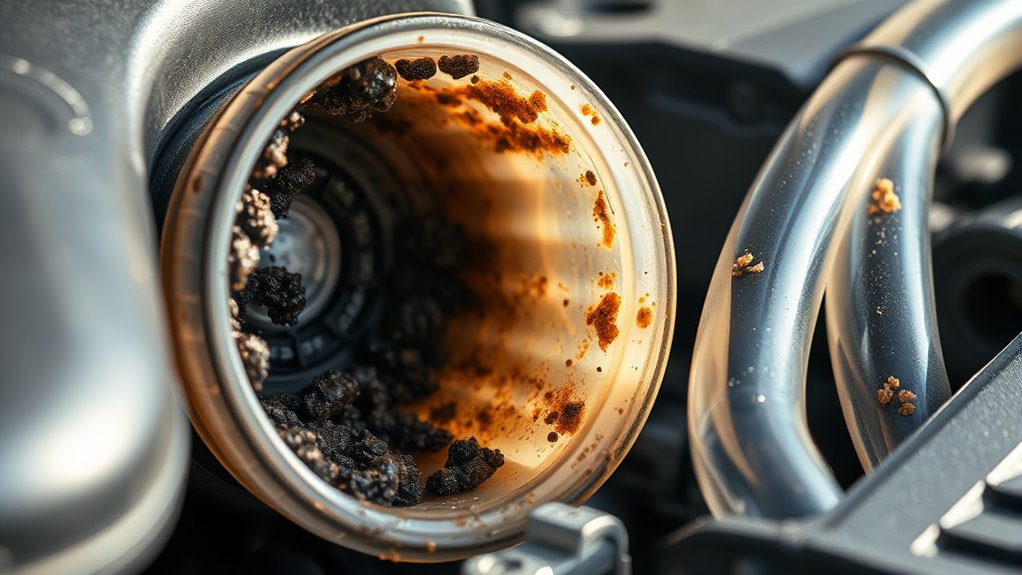If your vehicle starts to run roughly, stall, or hesitate, contaminated fuel could be the culprit. You might notice difficulty starting, increased exhaust smoke, or strange odors from the tank. Sluggish acceleration and poor fuel efficiency are also common signs. Visible debris, cloudy fuel, or sediment in your fuel or filter suggest contamination. Catching these symptoms early helps prevent serious engine damage. Keep going to discover how to quickly identify and address these issues.
Key Takeaways
- Look for engine hesitation, misfires, or rough idling as signs of contaminated fuel.
- Notice difficulty starting or frequent stalling, which may indicate water or debris in the fuel system.
- Detect unusual fuel odors or cloudy, discolored fuel that suggest dirt, algae, or water contamination.
- Observe increased exhaust smoke (black or white) and strange noises indicating poor fuel combustion.
- Regularly inspect and drain fuel if contamination is suspected to prevent engine damage and maintain performance.
Unusual Engine Performance Issues

If your engine starts behaving oddly, it could be a sign of fuel contamination. Contaminated fuel often leads to unusual engine performance issues, like rough idling, misfires, or a noticeable loss of power. Poor fuel storage can allow water, dirt, or bacteria to enter your tank, affecting how your engine runs. Sometimes, fuel additives designed to clean the fuel system can help, but if the contamination persists, it’s best to drain and replace the fuel. Keep an eye on the quality of your fuel and how you store it—using sealed containers in a cool, dry place minimizes risks. Remember, contaminated fuel hampers combustion, causing engine hiccups and inefficiency, so addressing these symptoms early can save you costly repairs later. Additionally, understanding fuel quality and proper storage practices can prevent contamination from occurring in the first place.
Difficulty Starting the Vehicle

Difficulty starting your vehicle can be a clear sign that contaminated fuel is affecting the system. When fuel isn’t pure, it can cause ignition problems and disrupt the fuel system’s performance. This leads to harder starts or the engine failing to turn over altogether. To understand if contamination is the issue, consider these signs:
- Your vehicle cranks but doesn’t start immediately.
- Extended cranking times with little to no engine response.
- The engine stalls or struggles shortly after starting.
Contaminated fuel hampers proper combustion, making it tougher for your ignition system to ignite the fuel efficiently. Recognizing these symptoms early can help prevent further damage and costly repairs. If you experience these issues, it’s a strong indicator that your fuel system might need attention.
Engine Misfires or Hesitations

When your engine misfires or hesitates during acceleration, contaminated fuel could be to blame. Fuel contamination can disrupt the combustion process, causing rough running and hesitation. Using fuel additive benefits can help improve fuel quality and protect your engine from contaminants. These additives can stabilize fuel, prevent deposit buildup, and keep injectors clean. To avoid engine misfires, consider contamination prevention strategies like regularly refueling from reputable stations and using fuel stabilizers if your vehicle sits unused for extended periods. Proper maintenance and quality fuel ensure smoother operation and reduce the risk of misfires caused by contaminated fuel. Addressing these symptoms promptly helps safeguard your engine’s health and keeps your vehicle running reliably. Incorporating preventive maintenance practices, such as routine fuel system inspections, can further minimize the chances of fuel-related issues.
Reduced Fuel Efficiency

Contaminated fuel can considerably reduce your vehicle’s fuel efficiency, causing you to spend more at the pump. When fuel is tainted, your engine struggles to run smoothly, leading to higher fuel consumption. To prevent this, consider using fuel additives designed to clean your fuel system and improve combustion. Proper storage of fuel is also essential; store fuel in sealed containers in a cool, dry place to minimize contamination risk. Utilizing reliable fuel tracking can help you identify patterns of decreased efficiency early. Here are three signs you might notice with reduced fuel efficiency:
- Increased fuel gauge readings despite consistent driving
- Sudden drops in miles per gallon
- Engine struggles to accelerate smoothly
Being mindful of these symptoms and maintaining proper fuel storage helps keep your vehicle running efficiently and saves you money.
Unpleasant Fuel Odor

A strong, unpleasant fuel odor is a clear sign that your fuel may be contaminated or leaking. If you notice a distinct fuel smell around your vehicle or in the fuel tank area, it’s essential to act quickly. Odor detection is your first clue that something’s wrong with the fuel. Unpleasant fuel odors can indicate leaks, degraded fuel, or contamination from water or other substances. Don’t ignore this symptom, as continued exposure to fumes can be hazardous. You should inspect the fuel cap, lines, and tank for leaks or damage. If the odor persists, it’s best to have a professional check your fuel system to prevent further issues and ensure safe operation. Recognizing this symptom early helps maintain your vehicle’s performance and safety.
Presence of Contaminants in Fuel or Filter

You might notice visible debris or sediments in your fuel or filter, which can clog your system. Cloudy or discolored fuel is another sign that contaminants are present. Recognizing these symptoms early helps prevent engine damage and keeps your vehicle running smoothly. Additionally, fuel quality can significantly impact the presence of contaminants and overall engine performance.
Visible Debris and Sediments
When inspecting the fuel system, visible debris and sediments are clear signs of contamination. You might notice particles floating in the fuel or settled at the bottom of the tank, indicating poor fuel tank cleanliness. To address this, focus on these key areas: 1. Check for dark or cloudy deposits in the fuel tank, which suggest buildup. 2. Inspect the fuel filter for dirt, rust, or sediments that could clog it. 3. Look for sludge or particulate matter during filter replacement or fuel sampling. These signs mean contaminants are likely present, compromising fuel quality. Regular fuel filter inspection helps catch debris early, preventing engine issues. If debris is found, cleaning the tank and replacing filters will keep your fuel system running smoothly and ensure ideal engine performance. Being aware of the cycle of breakups can help understand underlying issues that might contribute to fuel system neglect or mismanagement.
Cloudy or Discolored Fuel
Cloudy or discolored fuel is a clear sign that contaminants have entered your fuel system, potentially harming engine performance. Poor fuel quality or improper fuel storage often causes this discoloration, allowing dirt, water, or algae to mix with your fuel. When fuel appears cloudy or takes on an unusual color, it’s a sign that foreign particles or moisture are present. These impurities can clog filters, reduce fuel efficiency, and cause engine misfires. Always inspect your fuel before use, especially if you store fuel for long periods. Using contaminated fuel can lead to costly repairs and decreased engine life. To prevent this, keep your fuel storage containers sealed and in a cool, dry place, ensuring your fuel remains clean and safe for your engine.
Sluggish Acceleration

Fuel contamination can cause noticeable sluggish acceleration, making your vehicle feel less responsive than usual. When fuel is contaminated, your engine struggles to generate power efficiently. This often results in slower acceleration and a hesitant feel when pressing the gas pedal. To understand the root cause, consider these factors:
- Poor-quality fuel additives can leave residues that clog fuel injectors.
- Old fuel stored for long periods may degrade, affecting combustion.
- Contaminants in fuel storage tanks can introduce dirt or water into your fuel system.
- Using vetted fuel brands and additives can help reduce the risk of contamination and maintain engine performance.
Addressing sluggish acceleration involves draining contaminated fuel and cleaning fuel injectors. Proper fuel storage and using high-quality fuel additives can help prevent this issue. Being aware of these signs helps you catch fuel contamination early before more severe problems arise.
Unexpected Engine Stalling

Unexpected engine stalling often catches drivers off guard, especially during low-speed driving or idling. If your engine stalls suddenly, it could be a sign of fuel contamination. To address this, perform a thorough fuel system inspection to identify any debris or water in the fuel. Contaminated fuel can clog fuel filters or disrupt the fuel pump, causing the engine to stall unexpectedly. Regularly checking your fuel quality and preventing contamination is key to avoiding this issue. Using fuel stabilizers and buying from reputable stations can help prevent contamination in the first place. If stalling persists, don’t ignore it—prompt inspection and cleaning of your fuel system can save you from costly repairs and keep your engine running smoothly. Understanding the causes of fuel contamination can help you take proactive steps to prevent engine issues.
Increased Exhaust Smoke or Unusual Noises

If you notice increased smoke from your exhaust or hear unusual noises during operation, it’s a strong sign that your fuel may be contaminated or there’s an issue within the fuel system. These symptoms directly affect your vehicle’s exhaust emissions, often resulting in abnormal vehicle exhaust. Unusual noises, like knocking or sputtering, can signal improper combustion caused by contaminated fuel. Additionally, increased exhaust smoke—especially black or white smoke—indicates incomplete fuel burning or oil burning. To diagnose the problem, consider these key points:
- Check for black smoke: Indicates excess fuel or incomplete combustion.
- Listen for knocking sounds: Suggests misfiring or poor fuel quality.
- Inspect vehicle exhaust: Look for unusual colors or emissions patterns.
- Be aware of the importance of proper fuel quality to prevent engine damage.
Frequently Asked Questions
Can Contaminated Fuel Cause Long-Term Engine Damage?
Yes, contaminated fuel can cause long-term engine damage if left untreated. When fuel additives or fuel storage issues introduce debris or water into your tank, it can lead to corrosion, clogged injectors, or damaged pistons over time. To prevent this, regularly use fuel stabilizers, especially during storage, and guarantee your fuel is clean and fresh. Proper maintenance keeps your engine running smoothly and avoids costly repairs later on.
How Quickly Does Fuel Contamination Typically Affect Vehicle Performance?
As soon as your fuel degrades or becomes contaminated, you’ll notice performance issues almost immediately. You might experience rough idling, hesitation, or power loss, signaling that contamination detection is needed. Don’t delay; contamination can affect your vehicle’s performance within miles, especially if the fuel is severely compromised. Regularly check your fuel, and address problems quickly—otherwise, you risk long-term damage that’s costly to repair.
Are Certain Vehicles More Susceptible to Fuel Contamination Issues?
Yes, certain vehicle types are more susceptible to fuel contamination issues. Vehicles with complex fuel systems, like diesel engines or older models, tend to be more vulnerable because their fuel systems can trap contaminants more easily. Additionally, smaller or high-performance vehicles often have tighter fuel system tolerances, making them more prone to problems caused by contaminated fuel. Regular maintenance and using quality fuel can help protect your vehicle from these issues.
What Are the Safety Risks Associated With Driving on Contaminated Fuel?
Driving on contaminated fuel is like steering through a minefield, risking engine safety and your vehicle’s fuel system. Contaminants can cause misfires, stalling, or even engine damage. These issues may lead to costly repairs and dangerous breakdowns. Ignoring symptoms puts you at risk of engine failure, increasing the chance of accidents. Always guarantee your fuel is clean to protect your engine safety and keep your vehicle running smoothly.
How Often Should I Check My Fuel for Contamination?
You should check your fuel for contamination regularly, ideally every time you fill up or at least once a month. Conduct fuel testing if you notice engine performance issues or strange smells. Consistent testing helps with contamination prevention, ensuring your fuel stays clean and your engine runs smoothly. Stay vigilant by inspecting your fuel and tank periodically, especially if you notice any symptoms of contamination or if you’ve recently stored fuel for a long time.
Conclusion
Now that you know the telltale signs of fuel contamination, you’ll spot problems before they worsen. Keep an eye out for engine hiccups, strange odors, or sluggishness—these clues are your modern-day equivalents of a knight’s warning bell. Address issues promptly to avoid costly repairs, much like a trusty squire tending to his knight’s steed. Stay vigilant, and your vehicle will serve you faithfully through many a journey to come!





